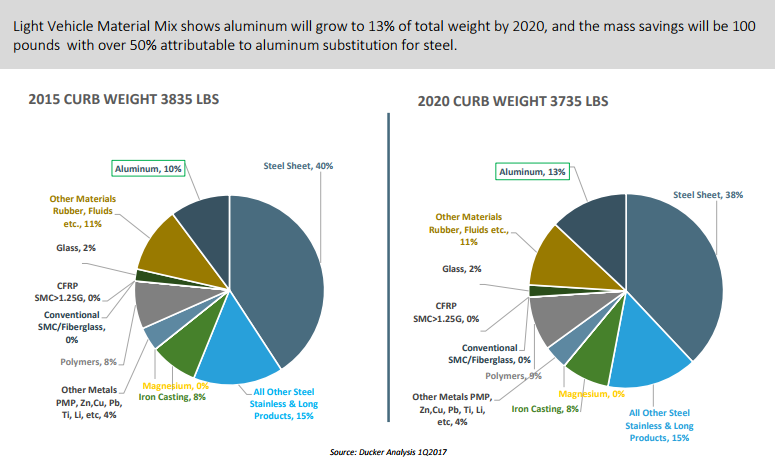

A survey of automakers conducted by Ducker Worldwide has revealed that the use of high-strength, low weight aluminium in new car and truck construction would increase at a record pace over the next decade. Total aluminium content in vehicle is expected to grow from 397 pounds per vehicle (PPV) in 2015 to 565 PPV by 2028, contributing 16% of total vehicle weight. This will be supported by the growing trend of automakers transitioning to a multi-material vehicle (MMV) design for lightweighting that is using aluminium for doors, hoods and trunk lids, body-in-white, bumpers and crash boxes.

“Aluminium remains the fastest growing automotive material over competing materials and is entering its most unprecedented growth phase since we’ve been tracking the shifting mix of automotive materials,” said Abey Abraham of Ducker Worldwide.
“To further improve fuel economy, battery range, safety and overall driving performance, automakers no longer default to a single material and instead are pursuing a multi-material design approach where the best material is chosen for the best application. This design evolution is what’s driving aluminium’s increased market penetration in the auto sector,” he added.
“On top of 40 years of uninterrupted growth, the aluminum industry is experiencing a level of sustained growth not seen before in any market or product sector. However, the true winners of this change are American consumers who can choose next-generation cars and trucks that are high performing, efficient, safe, sustainable and more fun to drive,” said Heidi Brock, president and CEO of the Aluminum Association.
“It is proven that vehicles made lighter with aluminum offer consumers better fuel economy, improved safety and enhanced performance,” she added.
According to the study, aluminium content for North American lightweight vehicles will increase to nearly 9 billion pounds, averaging 466 PPV by 2020 from 69 PPV in 2015. The use of aluminium hoods expected to reach 71% penetration from current 50%. 50% of total aluminium content growth from 2015 to 2020 will be driven by closures, crash management systems, steering knuckles and structural vacuum die cast parts. Aluminium vacuum die castings are expected to reach 14 PPV by 2020 from less than three at present. The aluminium content in average passenger car will reach 362 pounds and for light trucks, it will reach 523 pounds by 2020.
Going beyond 2020, Ducker projects that, by 2028, total aluminium content would reach 565 PPV (16% of total mass) with nearly 25%of vehicles having partial aluminium body-in-white. More than two million of those vehicles will be pickup trucks and 400,000 will have plug-in hybrid or zero-emissions powertrains.
{googleAdsense}
Since 1996, the Aluminum Association’s Aluminum Transportation Group (ATG) has commissioned global consulting and research firm Ducker Worldwide to conduct a survey of automakers. To get more details on the report, users can visit www.drivealuminum.org.
Responses








